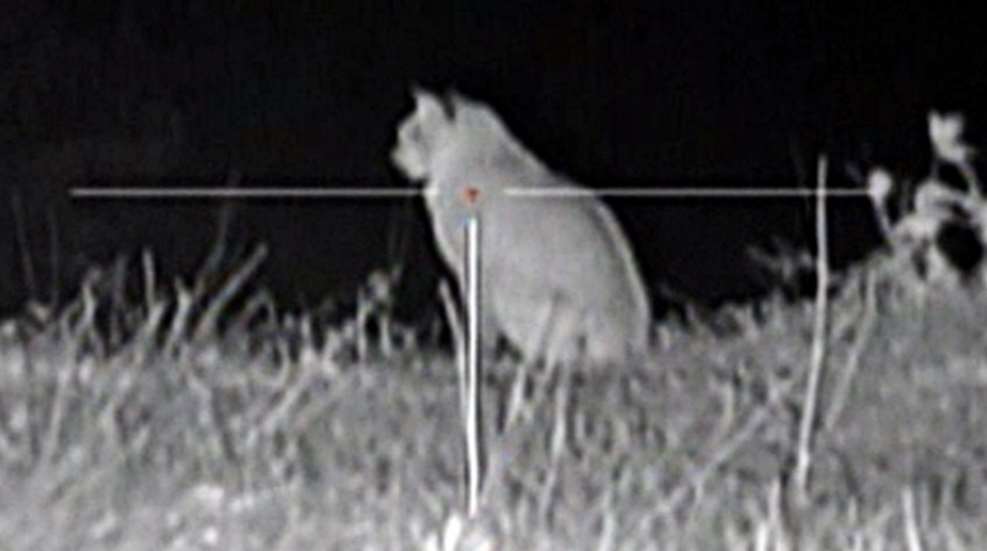
Donning night vision goggles for the first time can be a life-changing experience. That’s how I remember it from my days as a young Marine in the early 1990s. I first strapped on AN/PVS-7B Gen III goggles because, well, moonbeams were scarcely adequate for finding my way to the head. Also, the use of flashlights and cigarettes in blackout conditions were cause for a beating—you’d be surprised at just how far away they can be seen.
The night-vision devices (NVD) of that period were staple gear only for a select few, such as HMMMV (Humvee) drivers, because jumping behind the wheel during a blackout, with little or no light, was a recipe for disaster. Still, driving with PVS-7B Gen IIIs was tricky at best. More than once, shaded ground turned out to be eroded holes and ditches.
Few things come easy in the Marine Corps, including driving with NVDs, but the goggles were a necessity and quite a welcome tool considering the thought of running an archaic PVS-5 Gen I … or nothing at all. Of course, thermal was also in use, but it was essentially folklore for most of us. Honestly, even the military’s current PVS-14 Gen III night vision monocular is far from ideal, especially for driving or high-speed movements; however, the PVS-14 continues to hold its own on a firearm.
And, while I consider how mind-blowing night vision was for us decades ago, the PVS-7B’s technology, even by today’s consumer standards, seems a bit archaic, especially considering the digital-night-vision and thermal-imaging optics currently available and in use by law enforcement, security personnel, shooters and hunters. That said, understanding the origins of night vision and thermal helps paints a clearer picture of today’s exciting and affordable technology.
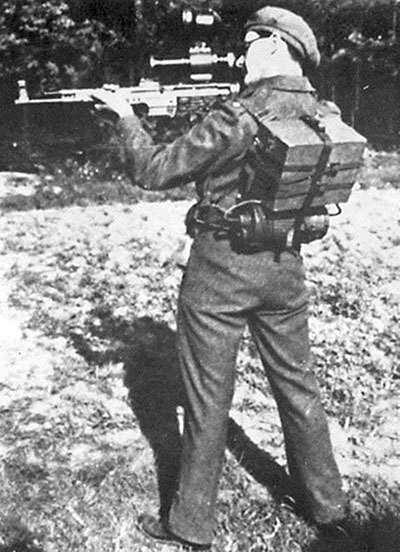
A Snapshot History Of Night Vision
Believe it or not, night vision is rooted in World War II-era innovation. During the war, Germany, followed quickly by allied forces, employed near-infrared (NIR) riflescopes. In a nutshell, these devices featured a large NIR light mounted above a riflescope. The top-mounted light cast significant NIR illumination. Essentially, the light reflected off the target, bouncing back into the riflescope where an image tube multiplied it. Roughly 10 years later, in the mid-50s, just after the Korean War, technology finally made its way into generational night vision with an improved tube and a more efficient NIR illuminator. Today, three generations of night vision are available for military, law enforcement and consumers alike.
Know Your Night Vision
Woody Harrelson’s character in the movie “Doc Hollywood” said it best, “I could have been a doctor. It was the science I had a problem with.” Understanding night vision can be difficult as it’s all high-tech. But in the simplest terms I can muster, night vision is considered to be either active or passive.
Active night vision requires the use of infrared (IR) illumination or, in the case of the World War II iteration, NIR and other Gen 0 devices. Passive night vision is exceptionally efficient at gathering all available light for processing, including from stars, the moon and industrial light sources. While passive night vision effectively harnesses light particles, it still does not do as well as one might hope on moonless nights—you know the kind; you can’t see the ground beneath your feet. Fortunately, passive devices also include IR illuminators designed to create the light you need to expose the field of view, at least as far as the light’s throw.
The light gathered by Gen 1 to Gen 3 devices comes from every imaginable source in the form of particles known as photons. They pass through the objective lens and into the image-intensifier tube where three elements are housed—the photocathode, microchannel plate and phosphor screen. Once the photons enter the image intensifier tube, they pass through the photocathode and are converted into electrons. The electrons then move through a multi-channel plate covered in microchannel tubes. As the electrons pass through the microchannel tubes they are converted into exponentially more electrons before continuing to the phosphor screen where they are converted back into photons, this time, to create the image you are viewing in a green hue.
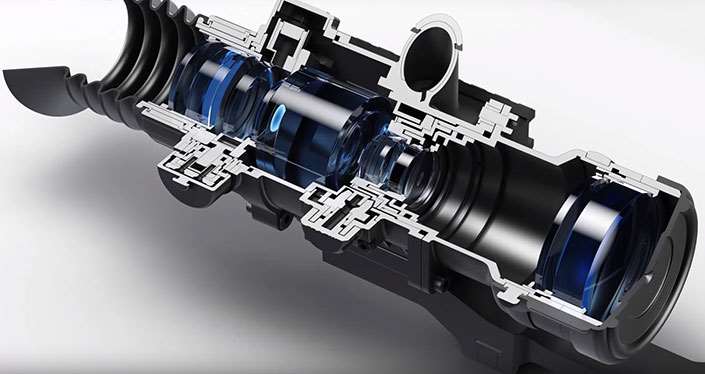
What’s The Deal With Generations?
Today’s traditional night vision devices, excluding digital night vision (DNV), consist of three generations commonly referred to as Gen 1 (I), Gen 2 (II) and Gen 3 (III). A few companies offer “Gen 4 (IV)” products; however, no military branch currently recognizes Gen 4, including, most importantly, the U.S. Army Night Vision and Electronic Sensors Directorate. Tasked with ascribing and defining generation-level requirements, this office has yet to accept Gen 4 night vision technology. If you’re in the market for night vision, read through the following descriptions of the various generations so that you can determine which level best fits your needs.
Gen 1: While the earliest version of night vision, Gen 0, was active, Gen 1 units are typically passive. Even so, due to limitations, these devices still benefit from IR illumination in most environments. Originally available in the 1960s and used in Vietnam (AN/PVS-5), Gen 1 optics deliver the green-screen goods up to roughly 75 yds. away, perhaps even 100 on a clear, moonlit night. As the most affordable night vision currently available, display resolution takes a hit; it’s often grainy. In Gen 1 optics, “blooming” is also an issue—the field of view becoming completely obscured by a bright light.
Gen 2: Continued development gave rise to Gen 2 devices in the 1970s. Original Gen 2 devices were smaller and much better-suited for both handheld and helmet-mounted use. Gen 2 devices incorporate improved, more compact tubes and better gain. Resolution was dramatically increased, and blooming was largely resolved. The Gen 2 detection range was also substantially increased; most Gen 2 optics are capable of reaching out to 200, even 250 yds. Of course, more compact Gen 1 and Gen 2 models are available to consumers today and are well-suited for handheld, helmet-mounted and firearm-mounted tasks.
Gen 3: Considered the crème de la crème of night vision, at least for regular Joes like me, Gen 3 arrived in the late 1970s/early ’80s and boasts a rich, high-resolution image. The most dramatic improvements over Gen 2 include an extended range, upwards of 400-plus yds., and auto-gating for reduced blooming and effective use in a wide range of lighting conditions. Gen 3 also improves on passive use—the ability to run a Gen 3 night-vision device without IR—however, most optics do include an onboard IR, and numerous manufacturers offer incredibly powerful, optic-mountable IR illuminators to take your detection range even farther, some as far as 500 yds. As a side note, while auto-gating certainly increases the ability to operate units in changing light conditions, I would be careful about running traditional night vision during daytime. Daytime use of a night-vision optic is a job best-suited for today’s digital night vision.
Depending on the generation, night vision can be expensive. Gen 1 devices usually cost between $200 and $600, while Gen 2 averages $1,000 to $3,000 and Gen 3 is a bank-breaker for many folks at $3,000 to $6,000. As a side note, Gen 1+ and Gen 2+ optics also are available and generally rest at price points on the high end of those just mentioned. That’s a lot of dough for an optic you can’t run 24/7; so, what’s the solution? Enter digital night vision.
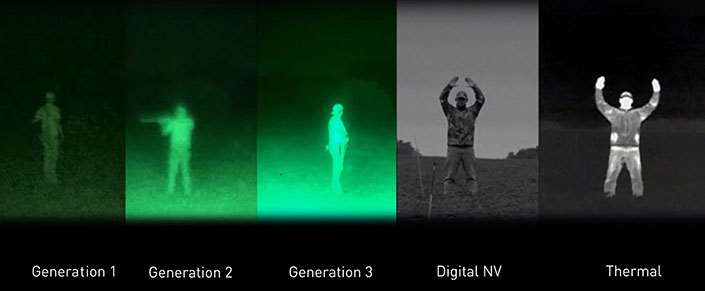
Putting The Digital In Night Vision
Today, digital night vision optics with improved sensors—most often a charged coupling device (CCD)—are designed to deliver flawless performance day or night without the need for a special lens cover. Sure, digital night vision scopes are, in fact, night vision scopes through and through; however, they process differently … digitally speaking. Digital night vision incorporates an electric signal. Remember, traditional night vision follows this process: Photons become electrons, which become exponentially more electrons before converting back into photons again to create an image on a green display. Digital night vision, on the other hand, works in the following manner: Light particles enter the objective lens and are converted to an electric signal in a high-tech CCD sensor. The electric signal is sent to a display, often a liquid-crystal display (LCD) or active-matrix organic light-emitting diode (AMOLED). Digital night vision displays are often black and white; although several color filters also are available.
Digital night vision performance has averaged between Gen 1+ to Gen 2+ generations without paying an arm and a leg for top-end imaging at either level. Current prices average $500 to $2,500—not bad for an optic you can use day or night.
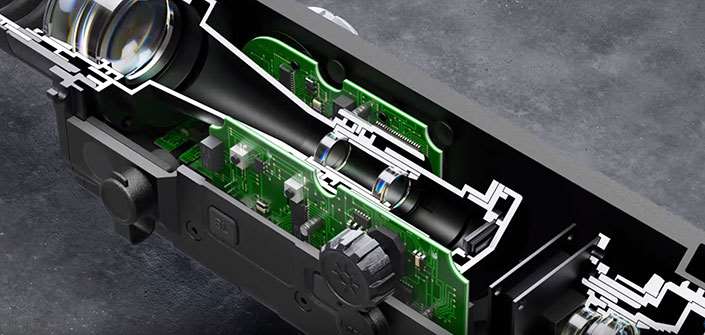
The Game Changer: Thermal
Few hunts have stuck with me as well as the first time I used thermal. After nearly 15 years of night hunting with white lights, laser illuminators and high-intensity, colored LED lighting—including bow-mounted systems complete with pressure switches—and killing more hogs than I could count, I finally had the chance to hunt with thermal. While on a hunt with Brett Jepsen and Charles Spiegel of Three Curl Outfitters in Waxahachie, Texas, a couple of years ago, Brett spotted a sounder roughly 1,000 yds. away from our position, just off the side of a rural farm road paralleling a freshly planted crop field.
I couldn’t see a thing as we slipped out of the truck and onto the muddy field; the moonless night kept its secrets well. I couldn’t see the ground at all, and following some semblance of their silhouettes proved challenging; the last thing I wanted to do was fall behind. After a lengthy trek across the field we stopped and fanned out side-by-side to establish a firing line, assumed comfortable shooting positions, then settled in behind our rifle-mounted thermal scopes.
In the darkness, their figures rose like ghosts on my display. The hogs literally glowed brightly in my optic’s field of view—amazing since seconds earlier I could barely make out my hand in front of my face. Not only could I see the hogs’ profiles, I could see details—their hair—and the rest of the field, trees and a distant rise behind them. My field of view, while manufactured and illustrated in black, white and hues of gray, was nearly as clear as daytime. Even before the first trigger pull I was hooked. Game-changing may be the most overused term when it comes to innovative outdoor products (innovative coming in a close second), but it’s the only word truly fitting the experience countless users have had, including me, when they first hunt with a thermal optic.
Thermal’s Origins
While night vision has been around for quite a while, thermal technology’s roots run even deeper—all the way back to 1800—when Sir William Herschel, the astronomer who discovered Uranus in 1781, was conducting brightness tests with tinted glass in relation to the sun. Testing the tinted-glass filters demonstrated varying heat transfers that ultimately, with the use of a thermometer and prism, revealed light beyond our visible spectrum that we term infrared radiation (IR). Sir William’s son, Sir John Herschel, also an astronomer, created the first thermal image in 1840 by exposing oil to a varying pattern of heat. He captured the image on paper and called it a thermograph.
For decades, after the Herschel family’s discoveries, the progress of thermal technology was slow, to be sure, but it picked up steam in 1880 when another astronomer, Samuel Langley, invented the bolometer, a heat (IR) measuring component foundational to today’s thermal technology. Langley’s work paved the way for Hungarian physicist Kálmán Tihanyi’s IR motion camera in the late 1920s, the first thermographic camera by Texas Instruments in the 1940s, single-line scanning in the 1950s, and even, some 40-plus years later, the smart sensors and uncooled microbolometer array systems so vital to current thermal imaging. But, how do today’s thermal imagers work?
How It Works
As a differentiating premise, night vision gathers particles of light and manufactures what it can using infrared illumination. Thermal does not throw infrared illumination, rather, it gathers infrared radiation emitted from objects at differing temperatures and displays the image as variations from black (cold) to white (hot).
Here’s the process in a nutshell: Emitted infrared radiation is focused through a Germanium objective lens and scanned by a phased array of detectors designed to construct a map of varying temperatures called a thermogram. The thermogram data is converted into an electric signal and sent to a processor. Finally, the signal is processed into data used to compose an image on the device’s display.
It took nearly 140 years to arrive at the current state in thermal technology. Fortunately, we’re all here to take advantage of thermal imaging’s latest advances in seemingly countless applications. Even better, thermal-imaging optics now include additional advanced technologies designed to enhance thermal experiences in a digital age and improve ethical decision making.
As an example, Pulsar’s Trail XP50 LRF Thermal Riflescope, unveiled at the 2018 SHOT Show, detects heat signatures up to 2,000 yds. away and includes other high-tech-yet-useful features such as 2X picture-in-picture, manual display- and distance-focusing, and robust zoom for long-range identification. The optic also includes WiFi for data downloads and video streaming, numerous reticles, white-hot and black-hot imaging modes and onboard video to capture all manner of footage, from a great hunt to evidence. As you might imagine, devices with these types of features help users make more informed decisions and utilize thermal technology in more meaningful ways, i.e. law enforcement operations.
The Many Faces Of Thermal
While I manage to eke out as many hog and predator hunts as I can with thermal riflescopes and monoculars, more important uses continue to mount as technology improves. In today’s world, while thermal imaging is perfect for hunting—including blood tracking, game recovery and walking in and out of your favorite hunting spots without spooking game animals—thermal is also often used by law enforcement for fugitive recovery, as well as surveillance.
In late January 2018, Patrol Lieutenant Joseph Ballew, with the McLennan County (Texas) Sheriff’s Office, used a thermal monocular from a helicopter hovering 800 yds. overhead to guide officers on the ground through a heavily wooded area to apprehend two thugs who fled a fatal vehicle accident. Even better, he recorded the event for evidence.
Thermals are also used by: fire departments to detect hot spots and other dangers; game wardens to observe and record illegal hunting activity, especially at night; border patrol agents and ranchers to detect illegal immigrants; boaters to locate overboard personnel and detect marine vessels running without lights; residents for personal defense; auditors for inspections; contractors, mechanics and homeowners for troubleshooting; and for many other applications—honestly, too many to list, but you get the idea.
As a side note, the cost of thermal has dropped dramatically. Less than 10 years ago, device costs averaged upwards of $10,000 to $25,000, depending on any number of features; however, here and now, consumer thermal optics can be found from about $1,700 to $6,500 or more, with averages between $2,000 and $4,000. Yes, you can own a dedicated thermal riflescope for about $1,700. That’s half the cost of some long-range day scopes.
Last Looks
While thermal imaging can and is used in a myriad of circumstances, we cannot discount the usefulness of night vision, especially today’s digital NV devices. Digital night vision can be used in many of the same ways as thermal, and is an even more suitable tool when a heat signature is less likely to be observed through obstructions. Insider secret: Observing a heat signature through the windshield of a car only works for the police officers you watch on TV.
At least now we’ve shed enough light on thermal and night vision optics to make you a dangerously conscientious consumer who can strike out on missions and hunts with realistic expectations. If you’re in the market to pull the trigger on thermal or night vision optics, your decision, like many purchases, comes down to determining what works best for your needs, wants, conditions and hard-earned cash. Either way, your field of view will never be the same.
In addition to his military and sporting experience and freelance writing career, the author is employed by Sightmark/Pulsar as a senior media relations specialist.
—The Eds






































